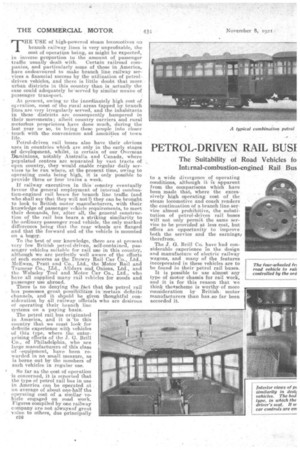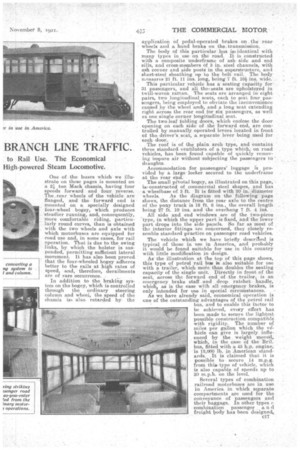PETROL-DRIVEN RAIL BUSI BRANCH LINE TRAFFIC.
Page 12

Page 13

Page 14

If you've noticed an error in this article please click here to report it so we can fix it.
T HE'USE of high-powered steam locomotives on
branch railway lines is very unprofitable, the cost of operation being, as might be expected, in -inverse proportion to the amount of passenger
traffic usually dealt with. Certain railroad companies, and particularly some of those in America, have endeavoured to make branch line railway services a financial success by the utilization of petrol-. driven vehicles, and there is little doubt that more urban districts in this country than is actually the ease could adequately be•served by similar means of
passenger transport. • At present, owing to the inordinately high cost of operation, most of the rural areas tapped by branch lines are very irregularly served, and the inhabitants in these • districts are consequently hampered in their movements; albeit country carriers and rural motorbus proprietors have done much, during the last year or so, to bring these people into closer touch with the convenience and amenities of town life. _ Petrol-driven rail buses also have their obvious uses in countries which are only in the early stages of development, whilst, in certain of our Overseaa Dominions, notably Australia arid Canada, where populated centres are separated by vast tracts of open country, they would enable regular daily services to be run where, at the present time, owing to operating costs being high, it is only possible to provide three or four trains a week.
If railway executives in this country eventually favour the general employment of internal combustion-engined rail buses for branch line traffic (and who shall say that they will not ?) they can be brought tp look to British motor manufacturers, with their knowledge of passenger vehiclerequirements, to meet their demands, for, after all, the general construction of the rail bus bears a striking similarity to the ordinary passenger road vehicle, the only marked differences being that the rear wheels are flanged and that the forward end of the vehicle is mounted on a bogey.
To the best of our knowledge, there are at present very few 13ritish petrol-driven, self-contained, passenger vehicles suitable for rail use in this country, although we are perfectly well aware of the efforts of such concerns as the Drewry Rail Car 0o., Ltd.., MeEwen, Pratt and Co., Ltd., the Motor Rail and Tramcar Co., Ltd., Alldays ands Onions, Ltd., and the Wolseley Tool and Motor Car Co., Ltd., who have all supplied many rail vehicles for goods and passenger use abroad. There is no denying the fact that the petrol rail bus possesses great possibilities. in .:eerta.in definite channels, and it sheuld be given thoughtful consideration by all railway officials who are desirous of operating their branch line systems on a paying basis.
The petrol rail bus originated in America and it is to this country that we must look for definite -experience with vehicles of this type, where the enterprising efforts of the J. 0. Brill Co., of Philadelphia, who are large manufacturers of this class of -equipment,, have been rewarded in no smsa,11 measure, as is borne out by the numbers of such vehicles in regular use.
So far asthe cost of operation is concerned, it is reported that the type of petrol rail bus in use in America can be operated at an average of about one-half the operating cost of a similar vehicle engage4 on road work. Figures compiled by one railway company are not always of great value to others, due principally
01.6 to a wide divergence of operating conditions, although it IS apparent from the comparisons which have been made that, where the excessively high operating cost of the steam locomotive and -coach renders the continuation of a branch line service almost prohibitive, the substitution of petrol-driven rail buses will not only permit the same service to be provided at less cost, but offers an opportunity to improve both the service and the earnings, therefrom.
The J. G. Brill Co. have had considerable experience in the design and manufacture of electric railway wagons, and many of the features incorporated in these vehicles are to be found in their -petrol rail buses.
It is possible to use almost any type of motor chassis for rail work, and it is for this reason that we think thesscheme is worthy of more consideration by British. motor manufacturers than has so far been accorded it. One of • the buses which we illustrate on these pages is mounted on a 21 ton Mack chassis, having four speeds forward and four reverse. The rear wheels of the vehicle are flanged, and the forward end is mounted on a specially designed four-wheel bogey, which produces steadier running, and, consequently, more comfortable riding, particularly round curves, than is obtained with the two wheels and axle with which motorbuses are equipped for road use and, in some cases, for rail operation. That is due to the swing links, by which the bolster is suspended, permitting sufficient lateral movement. It has also been proved. that the four-wheeled bogey adheres better to the rails at high rates of speed, and, therefore, derailments are of rare occurrence.
In addition to the braking system on the bogey, which is controlled through the ordinary steering column and wheel, the speed of the chassis is: also retarded by the application of pedal-operated brakes on .the rear wheels and a hand brake on the,transmission.
The body of this particular bus is: identical with many types in use on the road. It is constructed with a composite underframe of ash side and end sills, and cross-members Of 3 in, steel channels, with ash corner and side posts in the superstructure, and sheet-steel sheathing op to the belt rail. The body measures 21 ft. 11 ins, long, being 7 ft. 10i ins. wide.
This particular vehicle has a seating capacity for 31 passengers, and all the,i seats are upholstered in twill-woven rattan. The seats are arranged in eight pairs, two longitudinal seats, each to seat four passengers, being employed to obviate the inconvenience caused by the wheel arch, and a long seat extending right across the rear end for six passengers, as well as one single corner longitudinal scat.
The two-leaf folding doors, which enclose the door opening on each side of the forward end, are controlled by manually operated levers located in front of the driver's seat, a. separate lever being used for each door.
The roof is of the plain arch type, and contains three standardventilators of a type which, on road vehicles, has been found capable of quickly removing impure air without subjecting the passengers to aughts.
Accommodation for passengers' luggage is provided by a large locker secured to the underfraane • at the rear end.
The small pivotal bogey, as illustrated on this page, iseconstructed of commercial steel shapes, and has a wheelbase of 3 ft. It is fitted with 20 in. diameter wheels. As the diagram on the following page ahow, the distance from the roar axle to the centre of the pony truck is 16 ft. 6 ins., the overall length being 27 ft. 10 ins, and the overhang 7 ft. 4 in All side and end windows are of the two-piece type, in which the upper part is fixed, and the lower • part drops into the side panels. So far as most of the interior fittings are concerned, they closely resemble standard practice on passenger road vehicles.
The vehicle which we have briefly descritied is typical of those in use in America, and probably i it would be found suitable for use n this country with little modification in design.
As' the illustration at the top of this page shows, this type of petrol rail bus is also suitable for use with a trailer, which more than doubles the seating capacity of the single unit. Directly in front of the seat, across the forward end of the -trailer, is an emergency brake staff and drop ratchet handle, whie,h.1 as is the case with all emergency brakes, is only intended for use in special circumstances.
As we have already said, economical operation is one of the outstanding advantages of the petrol rail bus, and to enable this factor to be achieved, every effort has been made to secure the lightest
possible construction compatible " with rigidity. The number of miles per gallon which the 14hide can give is largely influenced by the weight movet., which, in the case of the BriL bus, fitted with a 45 h.p. engine, is 12,000 lb. in American standards. It is claimed that it is possible to secure 14 m.p.g. from this. type of vehicle, which is also capable of speeds up to 30 m.p.h. on the level.
Several types of combination
railroad motorbuses are in use in America in which sesarate compartments are used for the conveyance of passengers and their baggage. In other types a combination passenger , a n freight body ha.s been designed,
form with stake sides. Ordinarypassenger-type steps afford a means of boarding this. platform.
It must ix fairly obvious to those with a knowledge of transport conditions that the field in this country for the petrol rail bus is very limited in extent. We certainly think that within defined spheres this type of vehicle possesses -advantages which call for recognition. It should e e r tainly interest railway cornpanics whose branch line traffic is in need
o f economical Three-quarter front view of a petrol
e v dap/lent. It must be remembered that the rail bus is really a dual-purpose vehicle, inasmuch as the front bogey and rear flanged wheels can readily be supplanted by ordinary rubbertyred wheels, thus enabling the vehicle to be employed on the road.
It is solely because the ordinary type of goods or passenger chassis can be rendered suitable for rail use that we suggest that British motor vehicle guard against obstructions, saf manufacturers should consider the possibilities of this market for the absorption of a proportion— small as it may be--of their works output.
Severalfmotor manufacturers in America have set themselves out tr meet the demand whichbeing •experienced for the railway type passenger bus. The White Automobile Co., for instance, t h e producers of the White lorry, have installed in their werks a lathe for the purpose of turning out steel flanged wheels with which their road vehicles are equipped when it is desired to employ them on railway tracks_ F.W.D. vehicles have also been adapted to rail work.
The Americans have devised a method which enables a rail vehicle to be turned round and made to face in the opposite direction on a single line without using a railway-type turntable. The rail bus is equipped with a small turntable in the centre of the chassis, and in order to change its direction it is jacked up. the supportsbeing bridgedby a plank on which the vehicle pivots.
-driven rail bus, showing fender to safe' entrance, and rear luggage locker.
































